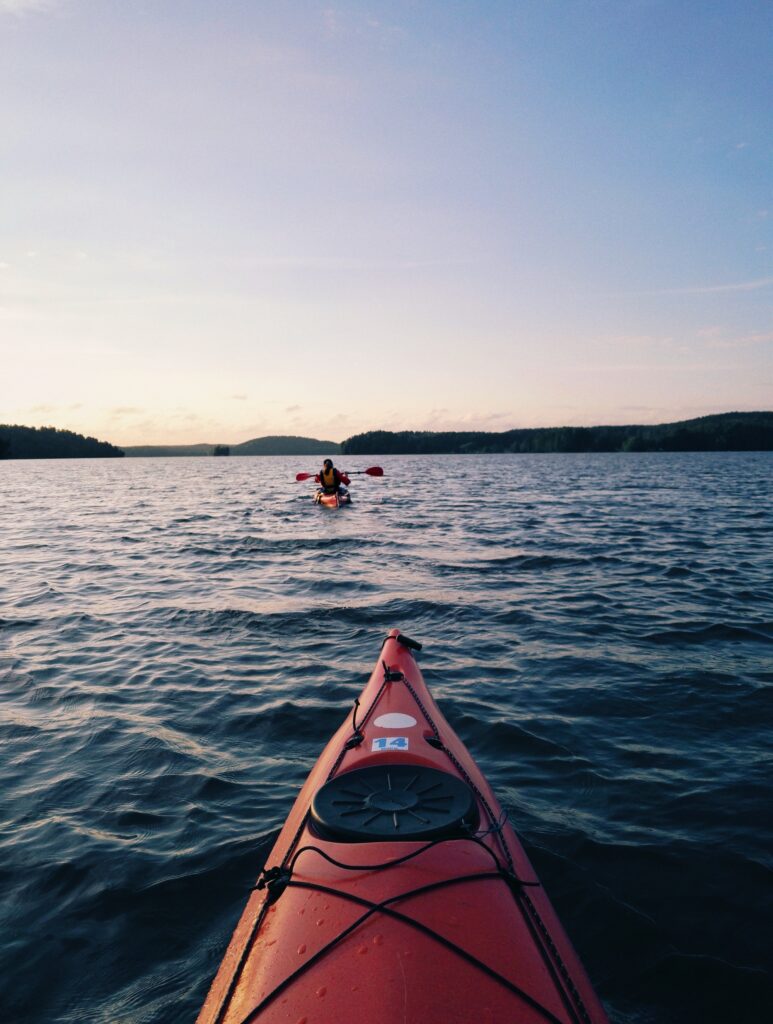On a recent vacation trip in the eastern U.S., I went canoeing with family members on the Delaware River. The region had been the homeland of the Lenape Native Americans, who called the river Lenapewihittuk (Lenape River). It is the largest river in the region, running about 400 miles from the Catskill Mountains in New York to the Delaware Bay.
Our canoe trip traversed just a portion of the river, in the Delaware Water Gap National Recreation Area. Because it was mid-week (and raining part of the time), there were very few other people out on the river. Much of the time it seemed we had the river to ourselves… except for the ducks, herons, turtles, bald eagles, fish, dragonflies, and many other creatures who joined us in the water, air and forested river banks.
As we paddled along, I was mesmerized by the strength of the water flowing so powerfully, as it had for thousands of years. Sometimes it was disturbed by wind and rain, riffles, rocks and islands. Other times it was so broad and smooth that it looked like glass, reflecting the trees and skies like a mirror, or providing a clear window to see long waving grass and fish under the water.
The river made me think of the deep current of God’s purpose and presence, which carries us along both in turbulent times and in calm seasons of our life. Sometimes we can see deeply and clearly into God’s justice, goodness and beauty. Other times our vision is obscured by obstacles that make the water churn, or circumstances that pelt us with pain or discomfort.
While in the canoe, I found that it was important to shift my gaze back and forth between the water under my paddle, and the riverbank at a distance. This gave me perspective on the canoe’s movement, direction, and location. In a similar way, it is important in faith and life to consider both the close-up experience of our personal lives, and also to lift our eyes and survey the wideness of God’s creation beyond our individual understanding.
And, I was not canoeing alone. I paddled in front (the bow of the canoe), and another person paddled in the rear (the stern). I watched for rocks ahead and did my part to propel the canoe forward, but it was not totally up to me to set the direction or movement of the canoe. We worked together – and sometimes we just floated, and let the river do its work.
I hope to take these lessons of the river back with me into daily life and ministry, trusting the current of God’s purpose and presence, as I paddle together with others in the canoe we call the community of faith.
Heidi Regier Kreider, WDC Conference Minister
———————————————————————————————————————————–
Reflejos Del Río
En un viaje de vacaciones reciente al este de los Estados Unidos, fui a navegar en canoa con miembros de mi familia por el río Delaware. La región había sido la patria de los nativos americanos Lenape, que llamaron al río Lenapewihittuk (Río Lenape). Es el río más grande de la región y se extiende a unas 400 millas desde las montañas Catskill en Nueva York hasta la bahía de Delaware.
Nuestro viaje en canoa atravesó solo una parte del río, en el Área Recreativa Nacional Delaware Water Gap. Como era a mitad de semana (y llovía parte del tiempo), había muy pocas personas en el río. La mayor parte del tiempo parecía que teníamos el río para nosotros solos … excepto por los patos, garzas, tortugas, águilas, peces, libélulas y muchas otras criaturas que se unían a nosotros en el agua, el aire y las riberas boscosas del río.
Mientras remamos, quedé hipnotizado por la fuerza del agua que fluía con tanta fuerza, como lo había hecho durante miles de años. A veces lo perturbaban el viento y la lluvia, rifles, rocas e islas. Otras veces era tan amplio y liso que parecía un cristal, reflejando los árboles y el cielo como un espejo, o proporcionando una ventana clara para ver la hierba y los peces bajo el agua.
El río me hizo pensar en la corriente profunda del propósito y la presencia de Dios, que nos lleva tanto en tiempos turbulentos como en temporadas tranquilas de nuestra vida. A veces podemos ver profunda y claramente la justicia, la bondad y la belleza de Dios. Otras veces nuestra visión se ve oscurecida por obstáculos que hacen que el agua se agite, o circunstancias que nos acribillan con dolor o malestar.
Mientras estaba en la canoa, descubrí que era importante cambiar mi mirada de un lado a otro entre el agua debajo de mi remo y la orilla del río a la distancia. Esto me dio una perspectiva del movimiento, la dirección y la ubicación de la canoa. De manera similar, es importante en la fe y en la vida considerar tanto la experiencia cercana de nuestra vida personal como también levantar nuestros ojos y examinar la amplitud de la creación de Dios más allá de nuestra comprensión individual.
Y no estaba navegando solo en canoa. Yo remaba al frente (la proa de la canoa) y otra persona remaba en la parte trasera (la popa). Observé si había rocas adelante e hice mi parte para impulsar la canoa hacia adelante, pero no era totalmente mi responsabilidad establecer la dirección o el movimiento de la canoa. Trabajamos juntos y, a veces, simplemente flotábamos y dejamos que el río hiciera su trabajo. Espero llevarme estas lecciones del río a la vida diaria y al ministerio, confiando en la corriente del propósito y la presencia de Dios, mientras rema junto con otros en la canoa que llamamos comunidad de fe.
Heidi Regier Kreider, WDC Ministra de Conferencias
